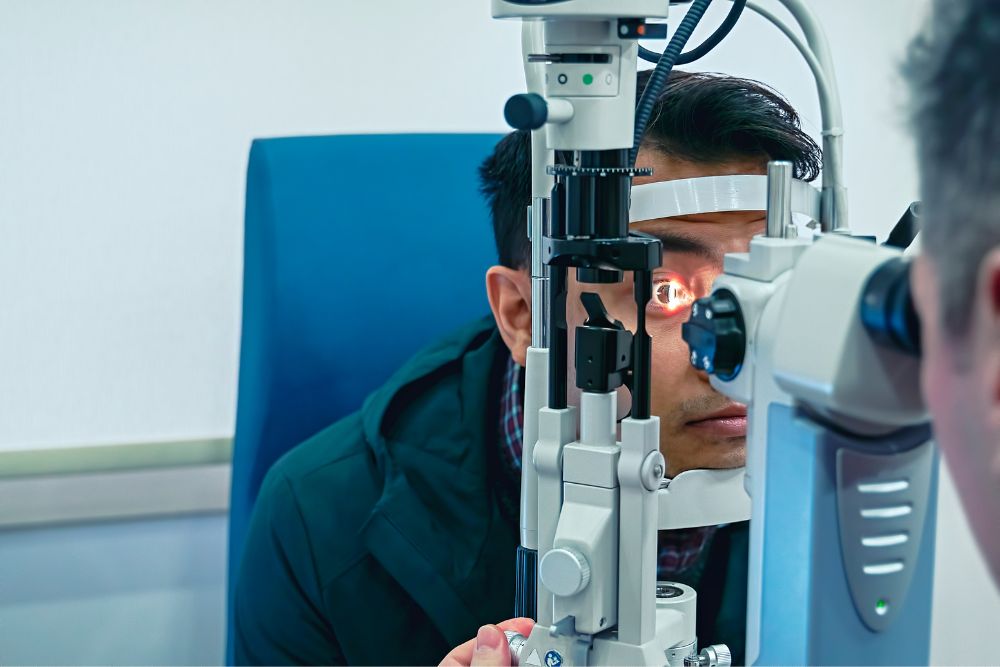Diabetic Eye Disease: Recognizing and Managing the Risks

Several eye diseases are known to affect people with diabetes. These conditions include glaucoma, cataracts, and the most common eye disease in people with diabetes, diabetic retinopathy. Diabetic retinopathy can exhibit mild to severe symptoms, or no symptoms at all, depending on the stage of the disease and other factors. But most importantly, if left untreated, it can result in vision loss. Early diagnosis and treatment, along with recognizing early signs and symptoms, are crucial to successfully managing the risks of diabetic eye disease. Learning about the risk of getting diabetic eye disorders empowers people with diabetes to take preventative action.
Types of Diabetic Retinopathy
There are two major types of diabetic retinopathy:
- Non-proliferative diabetic retinopathy (NPDR) – At this stage, the capillaries in the back of the eye balloon and form pouches. There may be no symptoms in the earliest stages of NPDR; the only way to know if you have it is to undergo a comprehensive diabetic eye exam from a retina specialist.
- Proliferative diabetic retinopathy (PDR) – As diabetic retinopathy is a progressive disease, PDR develops over time. This stage is characterized by damaged blood vessels and neovascularization (the development of new, weak vessels that may leak blood and impair vision).
It’s important to note that nonproliferative retinopathy is much more common than proliferative retinopathy.
Symptoms to Watch Out For
If you have early-stage diabetic retinopathy, you may not have any symptoms, but as the disorder progresses, symptoms may develop. Symptoms you should keep an eye out for include:
- Blurry or patchy vision
- Eye pain, pressure, or redness
- Floaters (dark spots or dark shrinks that float across your field of vision)
- Poor night vision
- Colors appearing faded or washed out
- Flashes of light
- Dark or blank areas in your vision
- Loss of vision
Note that the symptoms of diabetic retinopathy usually affect both eyes.
Other Diabetic Eye Diseases
Diabetic retinopathy isn’t the only vision-threatening condition that people with diabetes need to be aware of. For people with diabetes, the risk of blindness from eye disorders, such as glaucoma and cataracts, is much higher than that of people without diabetes.
Symptoms of glaucoma include:
- Headaches
- Blurred vision
- Lights appear surrounded by rainbow-colored halos
- Blind spots, tunnel vision, or low vision
- Nausea and vomiting
Symptoms of cataracts include:
- Cloudy or blurry vision
- Lights that give off a halo or glare
- Poor night vision
- Double vision
- Colors appear faded
- Visual distortion
Diabetic Eye Disease Risk Factors
Several factors influence whether a person with diabetes develops eye disease, including:
- Having diabetes for a long time
- Being over the age of 50
- The type of diabetes you have (people with type 1 diabetes are at higher risk of retinopathy)
- High blood sugar levels
- High blood pressure and cholesterol
- Being pregnant
- Tobacco use
- Certain ethnicities, such being African American, Native American, or Hispanic
- Genetic factors
When to See a Retinal Specialist
Understanding the risks associated with diabetic eye diseases is paramount for individuals with diabetes. Diabetic retinopathy, alongside other vision-threatening conditions like glaucoma and cataracts, demands vigilance. Early detection and intervention play a pivotal role in preventing vision loss. Armed with knowledge about risk factors and symptoms, individuals can proactively safeguard their eye health and seek timely medical attention, fostering a proactive approach to managing the complexities of diabetic eye diseases.
If you have diabetes, see your retina specialist for a yearly dilated eye exam – even if you have no problems with your vision. Contact The Retina Eye Center in Augusta, GA, and Aiken, SC to schedule a consultation with one of our expert retinal specialists today.
